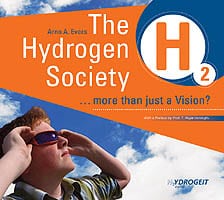
by Monika Roessiger | Apr 16, 2024 | Energy storage, Fuel cells, Germany, hydrogen development, international, News
Optimism at the H2 Forum in Berlin
A good 450 participants gathered at the specialist conference H2 Forum in Berlin February 19 and 20 to discuss innovative H2 technologies, strategies for the market ramp-up and the necessary regulatory framework conditions. A further 1,000 participants were connected online, even despite the considerable time difference in countries such as India and the USA.
The event was opened via a video by Kadri Simson, EU Commissioner for Energy. The two-day program was held under the motto “Empowering the future of hydrogen,” where this year’s focus was on the production of the green gas by electrolysis and its transport in Germany and Europe. At the H2 Forum were, among others, representatives from E.on, Enapter, EWE, Linde, FNB Gas and the H2Global Foundation. They discussed the role of hydrogen in the defossilization of the economic systems. Philipp Steinberg of the German economy ministry outlined the various phases of the development of the hydrogen core grid in Germany.
Advertisements

Feelings of optimism and assurance were tangible throughout the high-ceilinged rooms of the Estrel Congress Center (ECC) as players from politics, industry and the energy sector talked about ambitious H2 projects at home and abroad. Inspiring as well was the approval by the EU Commission a few days before of a series of IPCEI projects, thus ending for some participating companies years of waiting. Additionally, the carbon contracts for difference and the auctions of the European Hydrogen Bank are giving hope to business representatives.
Spain: Megawatt-electrolysis in practice
For example, Özlem Tosun, project manager for green hydrogen at Iberdrola Deutschland, reported on the experience with a 20‑MW electrolysis plant, making it currently the largest in Europe. “I hope it doesn’t stay that way,” she added, in view of the necessary market ramp-up for green hydrogen. The Spanish energy corporation, known in the country primarily as an operator of wind farms in the Baltic Sea, started operation of the plant in Puertollano, May 2022 in the presence of the King of Spain. The city with nearly 50,000 inhabitants is located about 250 kilometers south of Madrid. The electricity for the hydrogen production comes from a 100‑MW photovoltaic park a few kilometers away and flows via an underground cable into the production hall, in which 16 electrolyzers of 1.25 MW each perform their work. These produce annually up to 3,000 tonnes of green hydrogen, which is temporarily stored in tower-high pressure tanks at 60 bar. The electrolysis plant is located next to the fertilizer factory of Fertiberia and currently covers ten percent of their hydrogen requirement, which according to Iberdrola saves 48,000 metric tons of CO2.
“But this is just the beginning,” stressed Tosun. “In the coming years, Iberdrola wants to increase the production more than tenfold – to 40,000 tonnes by 2027.” The demand is there, since otherwise Fertiberia is using for its ammonia synthesis gray hydrogen obtained from natural gas. That no comparable plant for the production of green hydrogen on an industrial scale is yet in operation is also due to the fact that the whole thing is not as simple as it sounds in the big plans and letters of intent. “It didn’t go smoothly from the start,” admitted Özlem Tosun. “On the contrary – we had a lot of problems. But we also learned a lot and were able to improve a lot as a result. Not only technically, but also economically.” One of the most important points was to optimize the efficiency of electricity use. Contributing to this was that the performance and efficiency of the electrolyzers were able to be increased further and further.
Overall, the practical experience in Puertollano was important “to be able to scale the system.” As far as the large-scale production of climate-neutral energy sources is concerned, the multinational energy company not only sees itself as a pioneer, but is also optimistic about the future. Because Spain first wants to become independent of fossil fuel imports and then be able to export renewable energies. So it’s no wonder that Germany is for Iberdrola “a key market,” as Tosun says, “especially for green hydrogen.”
Lack of regulation as a stumbling block
How the development of a German and European hydrogen industry can be accelerated was one of many other topics discussed at the conference. It is important to break down barriers – for example lack of regulation and infrastructure – it was said in a panel discussion. Such hurdles, the speakers agreed, were in addition to the high costs for H2 production, like before, the crucial reasons why not a small number of companies, despite the positive feasibility studies, are still waiting with the final investment decision. The following figures show just how wide the gap is between aspiration and reality when it comes to the gas of the future: In recent years, the German government has raised the target for domestic production of green hydrogen from the original three gigawatts to ten gigawatts, yet so far not more than 62 MW of generation capacity has been installed. That there is a long way to go, but which can go faster, further practical examples have shown.
“Never waste a green electron again!”
“Did you know that with the wind power that was curtailed in the first half of 2022 alone 1.5 million households in Europe could have been supplied with electricity for a year?“ (The figure refers to average households with a consumption of 3,500 kWh per year.) That was one of several questions with which Alexander Voigt, managing director of HH2E, began his speech. “What could we do with all the green electrons that are not being generated only because the power grid cannot absorb them?” His answer, of course: Hydrogen! But also high-performance battery storage, to be able to offer energy for stabilization of the power grid. That’s how he explained the business model of the planned HH2E factory in Lubmin, Germany. It will use surplus electricity to “reliably and cost-effectively produce green hydrogen.” In addition will come CO2-free heating and, if required, the conversion of the “green molecules” back into electricity.
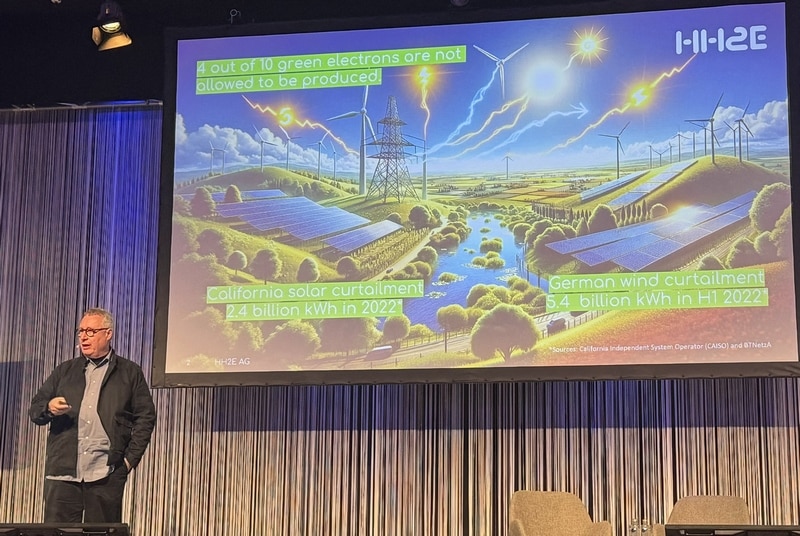
Alexander Voigt, CEO von HH2E, nutzt künftig Überschussstrom in Lubmin (Foto: Monika Rößiger), Source: Monika Rößiger
With this, the plant could contribute to the decarbonization of industry in Germany and, at the same time, support the energy supply. The final investment decision will be made shortly, according to Voigt, and then the way would be clear for the start of construction. In the year 2026, according to the plan, energy generation is to start: around 100 megawatts of total capacity in the first expansion stage, divided between a 56‑MW electrolyzer and a 40‑MW battery storage system. The electricity for electrolysis is coming from offshore wind farms in the Baltic Sea. Initially, the operators expect to produce around 7,200 tonnes of green hydrogen per year. The production capacity of the plant is scalable up to one gigawatt. Lubmin, once a transshipment point for Russian natural gas, will then become a center for green hydrogen. This can be fed into the existing natural gas grid that extends from the northeast of Germany to the southwest near Stuttgart.
In total, more than 40 companies from the entire H2 value chain presented their solutions and products in the high glass hall next to the conference hall in the Estrel Congress Center. The organizational framework of the H2 Forum was right: There was time to connect during the coffee breaks, lunch and supper. Lively discussions took place at all the tables and stands. That more politicians were present this time than at previous events was, according to Laura Pawlik, Sales Manager of the organizer IPM, particularly emphasized in the feedback from the participants. And also that the representatives from politics and administration were definitely open to further funding.
The date for the next conference has already been set: March 4 and 5, 2025, again in the ECC in Berlin. Focal points will be in addition to politics also the regulatory progress in Germany and Europe.
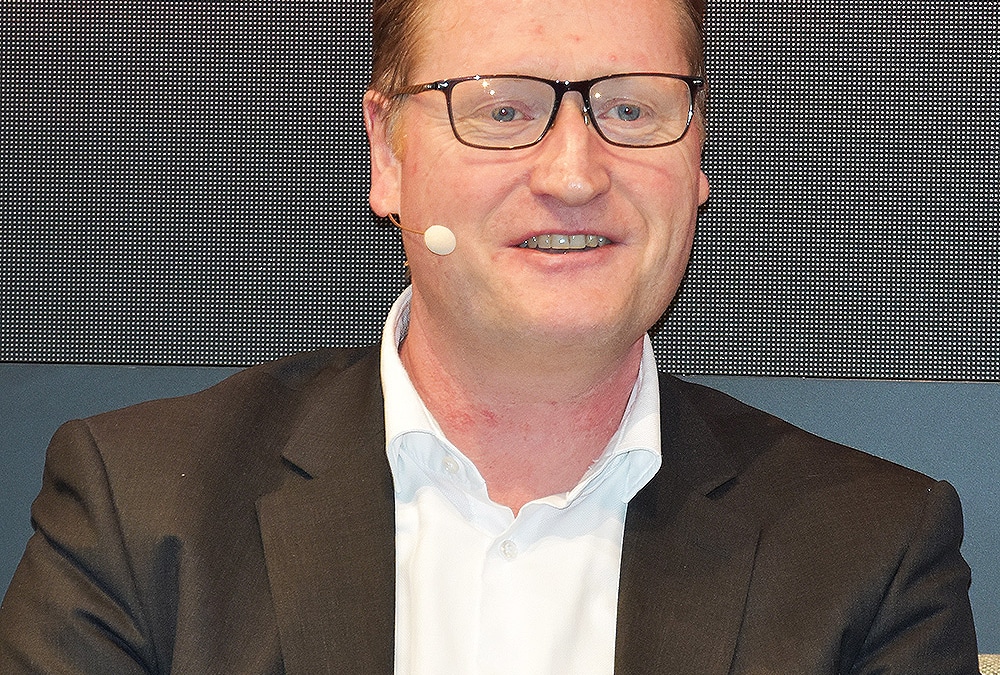
by Hydrogeit | Apr 15, 2024 | Energy storage, Germany, Policy, worldwide
Background to the Bonhoff/BMDV split
Things had quietened down on the Bonhoff front. But then new information surfaced in February 2024 which prompted German transportation minister Volker Wissing to take action. On Feb. 15, he released Klaus Bonhoff, head of the policy issues department, from his duties with immediate effect and also moved a divisional head. The reason behind the decision lies in a discrepancy uncovered during an internal review undertaken by the transportation ministry, also known as the BMDV. The affair gained added force when German news magazine Der Spiegel reported on Feb. 20 that Wissing had stopped “completely the approval of hydrogen funding.” Yet in reality funding is not being axed. The ministry is merely carrying out reassessments that could lead to a delay.
Advertisements

But one thing at a time. In this article we’ll attempt to shed light on who did what to whom as well as how and when it all happened.
It started back in summer 2023 when German business paper Handelsblatt published an article about a questionable friends and lobbying network. The suspicion of nepotism that was raised on various sides was based on the alleged existence of an overly cozy network of contacts linking a number of different political and industry figures. Bonhoff was reproached for his reported friendship with Werner Diwald, chairman of the German hydrogen association, and its president, Oliver Weinmann, both of whom he allegedly joined on a ski trip. What’s more, it was claimed that Bonhoff helped the German hydrogen association, abbreviated to DWV, to gain funding in 2021.
Stefan Schnorr, state secretary at the German transportation ministry, was tasked with clarifying the facts and, according to Der Spiegel, gave the all-clear a few weeks later, stating there was “No trace of favoritism.” At the same time, Bonhoff received broad support, particularly from the hydrogen sector.
Everything bubbled up again in early 2024 when Der Spiegel quoted parts of an email exchange between Bonhoff and Diwald (see freedom of information website www.fragdenstaat.de). This apparently substantiated a high degree of closeness and familiarity between the two men.
Inconsistencies and contradictions
In fact, what the disclosed emails show is that certain wishes and views regarding funding measures had been articulated on the part of the DWV. For example, Werner Diwald wrote in September 2021: “In view of the upcoming elections it would certainly be good for grant approval to be given before the end of this legislative period.” (Der Spiegel, Feb. 6, 2024)
This prompted Bonhoff to forward the email to the appropriate specialist department at the transportation ministry where he inquired after the state of affairs, according to the statement he gave to H2-international. As Der Spiegel and Tagesspiegel Background, another German publication, both reported, he also “orally supported” the project. However, given this expression of support was previously denied, this admission could now cause no end of trouble for the ministry.
LobbyControl then took it as proof that favoritism was indeed at play. On Feb. 16, 2024, the online platform stated that days before the ministry had conceded there were “inconsistencies and contradictions” in the allocation of funding and that is why minister Wissing relieved department head Klaus Bonhoff from his duties.
“The necessary relationship of trust between the minister and the head of department no longer exists.”
Stefan Schnorr, state secretary at the German transportation ministry, in the Frankfurter Allgemeine Zeitung (FAZ)
Furthermore, LobbyControl criticizes what it sees as the inadequacy of compliance rules at the transportation ministry and Bonhoff’s lack of a clear-cut separation between his personal and official contacts when it comes to grant allocation.
Overly cozy network?
Klaus Bonhoff, who is also known as “Mister Hydrogen” due to his extensive experience in leadership roles in the H2 and fuel cell sector, had previously worked for many years on fuel cell cars at Daimler before becoming managing director of Germany’s National Organisation Hydrogen and Fuel Cell Technology, or NOW, in 2008 (see HZwei, April 2011 & H2-international, October 2019). From there he transferred to his post at the German transportation ministry. His successor at NOW since May 2020 has been Kurt-Christoph von Knobelsdorff (see H2-international, February 2021).
Thanks to his considerable expertise, he was a popular and long-standing contributor at numerous industry events since he was well known as an adept public speaker with a skill for highly diplomatic and precise wording. It’s understandable that the DWV in particular wanted to get close to him given that the association comprises many major German industrial corporations from the H2 community and Bonhoff, in his role as NOW spokesman, was the main point of contact for funding applications in the hydrogen sector. However, the responsibility for awarding funds, both then and now, lies with the project management agency Jülich (PtJ).
The DWV’s role
Over the years, the DWV has developed – especially under the leadership of Werner Diwald – from a highly committed body of motivated idealists to an industrial lobbying group. Because of this change, some of the original members who prefer an idealistic approach have turned their back on the association in the past few years. Some of them have urged repeatedly for less dependency on industry and greater levels of transparency. Most recently, Johannes Töpler, who was a long-serving chairman of the DWV, resigned from his post as the DWV’s education officer at the turn of the year. Among the reasons for his resignation was that he no longer thought education and training, a crucial area in his view, was receiving the appropriate attention and appreciation it deserved within the work of the association.
In terms of legal form, the DWV is officially a registered association. Over the years, Diwald has worked to set up various expert commissions to which participating companies pay high-level contributions. This enables the DWV to represent their interests, including on the political stage in Berlin and Brussels. As such, political evenings and business talks are organized on a regular basis where political and industry representatives can meet, as commonly occurs in associations nowadays. One of these expert commissions, HyMobility, was awarded millions of euros in funding in 2021 via the PtJ, i.e., from the transportation ministry’s budget, something which Bonhoff is now being reproached for.
The ministry confirmed to H2-international: “The HyMobility innovation cluster is supported by the Federal Ministry of Transport and Digital Infrastructure as part of the national hydrogen and fuel cell innovation program. The grant is up to €1,438,600. The calculation is based on actual expenditure up to the maximum grant level. […] The HyMobility cluster is financed through grants, contributions for cluster membership, and a proportion of the membership contributions of the DWV. […] The funding project facilitates cluster management, cluster coordination, the support and guidance of the expert commission’s work as well as the preparation of findings from the expert commission and from the expert committees and the provision of recommended courses of action to meet further development needs. In addition, the funding covers the venues for cluster meetings, the creation of studies and analyses as well as technical and legal reports. […] The funding is allocated for specific purposes.”
HyMobility’s aims, according to its project outline, include: “Involvement in the formulation of relevant policy and legal conditions at a national and European level for the market preparation and introduction of low-carbon mobility based on renewable hydrogen. […] the creation and strengthening of understanding for and trust in innovative and low-emission vehicle technology based on renewable hydrogen within transport and national and European politics.”
In connection with this, the DWV confirmed to H2-international that the goals of the expert commissions are to “attract attention for the particular topic, raise awareness, bring together stakeholders from the relevant areas and sectors, prepare joint positions and recommend courses of action to policymakers.
LobbyControl makes the following criticism in relation to this: “It is unusual and questionable that an industrial lobbying association such as the DWV should receive a state subsidy for work that it would carry out regardless: maintaining networks and lobbying.”
“The HyMobility project is supported by the Federal Ministry of Transport and Digital Infrastructure through a total of EUR 1.8 million in funding as part of the national hydrogen and fuel cell innovation program. The funding guidelines are coordinated by NOW GmbH and executed by the project management agency Jülich (PtJ).”
https://dwv-hymobility.de/organisation/
Bonhoff told H2-international: “HyMobility is funded in the same way that the environment ministry funds the HySteel project which was approved prior to HyMobility.” Tagesspiegel Background reported on this very subject on Feb. 7, 2024: “The ministry [German environment ministry; editor’s note] is satisfied with the project. ‘Such networking is effective and successful, is conducive to the sharing of best practice and the establishment of horizontal and vertical partnerships in research, testing and production.’”
Among the 22 members of HyMobility are NOW and H2 Mobility Deutschland. H2 Mobility is a consortium of various automotive, industrial gas and petroleum companies plus an investment fund focused on the construction of hydrogen refueling stations in Germany. Practically every station that is built and managed by this Berlin-based company is subsidized to the tune of nearly 50 percent from European funds or the funds of German central or regional government. One of the three directors is Lorenz Jung (see H2-international, October 2023), who took up the role in April 2023. According to information from LobbyControl, he is the son-in-law of Oliver Weinmann. Jung, whose wife (Weinmann’s daughter) works at NOW in the communications department, has been a manager at the company virtually since its inception.
The roles of Weinmann and Diwald
Weinmann is a founder and board member of what was then the German hydrogen and fuel cell association (see HZwei, October 2010). Born in Hamburg, he had initially worked for city’s electricity company (Hamburgische Electricitäts-Werke or HEW) which was taken over by Swedish corporation Vattenfall Europe when it became the majority shareholder in 2001. Weinmann held the position of managing director at Vattenfall Europe Innovation GmbH from 2010 to July 2023, followed by head of innovation management at Vattenfall Europe AG. From 2020 onward he has also worked in a voluntary capacity as the president of the DWV. In addition, he is chairman of the NOW advisory council, vice chairman of the hydrogen body Wasserstoffgesellschaft Hamburg and holds or has held – according to his own HyAdvice website through which he offers freelance consulting services on matters including funding – further leadership positions at various organizations, among them Hydrogen Europe and the Energy Storage Systems Association or BVES.
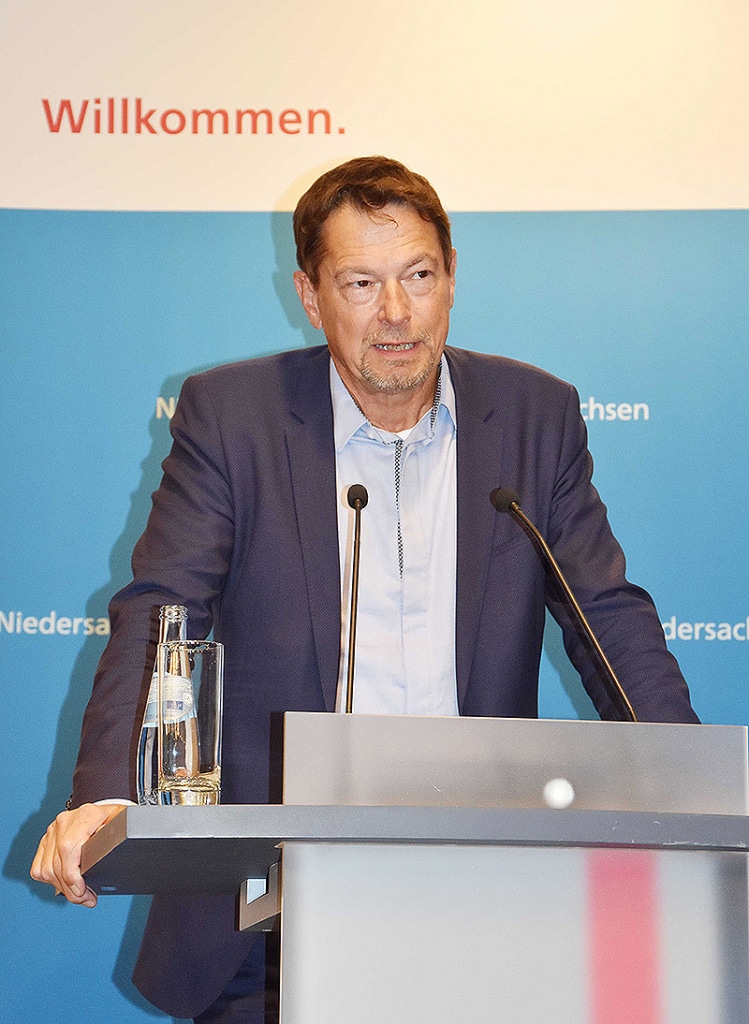
Oliver Weinmann at a parliamentary evening in Berlin in 2022
Similar to the way Weinmann operates with his HyAdvice consulting business, Diwald offers his services through PtXSolutions, formerly known as ENCON.Europe. The company is the vehicle through which the DWV chairman provides consultation as a sideline to institutions such as the DWV, Encon Energy EOOD (ENCON subsidiary), Enertrag (former employer), NOW, Performing Energy (DWV think tank) and Vattenfall Europe Innovation. Originally, ENCON.Europe had undertaken some work for the DWV (see H2-international, October 2020). According to a statement by Diwald, ENCON.Europe at the time played a considerable part in increasing the visibility of the DWV without itself appearing in the limelight. He says the company positioned the DWV and the Performing Energy expert commission exclusively as brands in the political sphere and negotiated in the interests of the association. From 2017, the company’s staff included Dennitsa Nozharova, Werner Diwald’s wife, who at the same time also worked for the DWV and is also involved in Encon Energy EOOD.
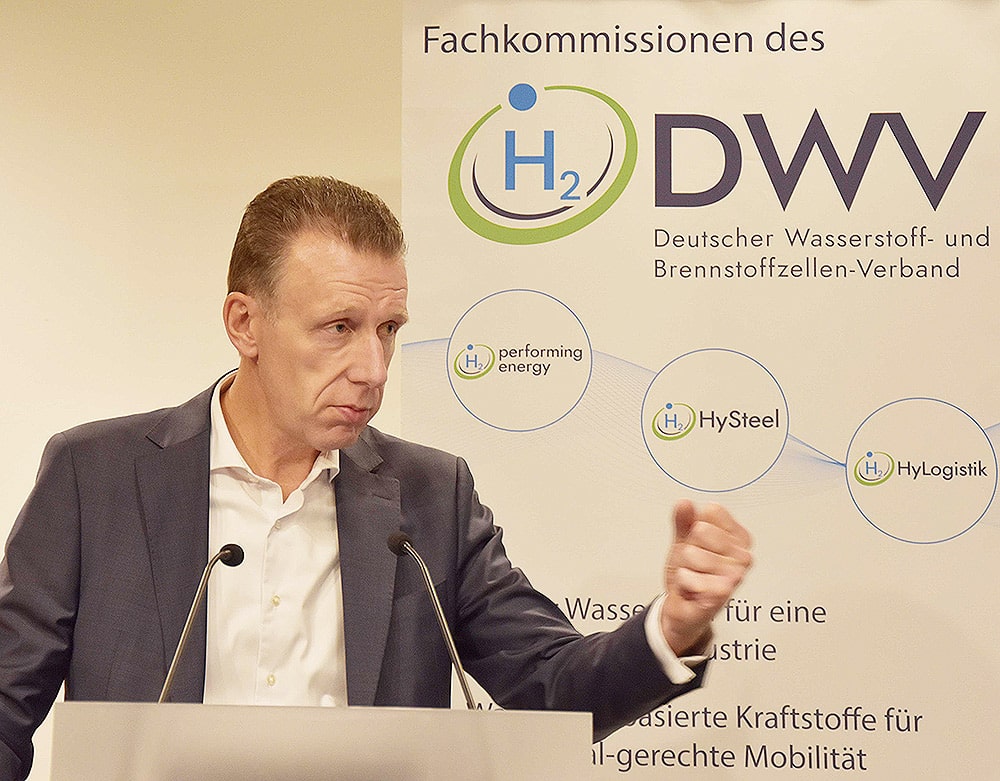
Fig. 3: Werner Diwald has been DWV chairman since 2014
Performing Energy was the first expert commission that the DWV initiated in 2015 on the back of Warner Diwald’s efforts; Diwald himself had previously created this alliance for wind-based hydrogen systems in 2011 and taken up the position of its speaker (see HZwei, January 2012). Participating organizations include Enertrag and Vattenfall as well as other companies which are also involved in other groups within the network.
Werner Diwald addressed the situation regarding some association members by stating in an email seen by H2-international: “The media’s assumptions about a possible breach by the DWV of compliance rules in relation to the funding application made by the HyMobility innovation cluster are unfounded. […] There was no improper influence exerted by the DWV. The DWV does not accept funding to carry out its statutory activities. […] By virtue of the funding of the HyMobility innovation cluster by the BMDV, the DWV has clearly not placed itself in a position of dependence on the government.”
Furthermore, the DWV has yet to issue a public statement, with the exception of a communication disseminated to association members (as seen by H2-international). The message sent, at the end of February 2024, outlined that “initial measures” have been “immediately introduced” that “go beyond the content of the DWV’s ‘Code of Compliance’ in order to make a comprehensive review of the situation.” It goes on to say that the DWV executive committee has “immediately commissioned a comprehensive review of the DWV’s compliance rules and of external and internal processes and procedures in the context of funding applications and funding allocations.” This is to be carried out by Berlin law office Redeker Sellner Dahs.
H2 funding frozen?
The saga then reached its peak after Der Spiegel reported that the transportation minister had allegedly frozen all funding for H2 projects. According to the article, no more funding is to be approved for the sector for the time being and no further agreements are to be concluded. Even amendment notices will require approval at state secretary level, it said.
However, a press spokeswoman for the ministry clarified the issue at a press conference on Feb. 21, 2024, by stating that the ministry had “not stopped hydrogen funding per se” but is carrying out more thorough assessments of funding applications. These “are currently focused on the approvals procedure for the DWV’s HyMobility funding project.” Should relevant evidence be produced during the investigation, further funding projects will also be examined more closely if necessary.
The reason for this tightened approach seems to be the Brunner affair. It relates, among other things, to the email exchange that took place via a personal GMX account through which Klaus Bonhoff and others communicated with Bavarian businessman Tobias Brunner, managing director of Cryomotive and Hynergy and a key figure in establishing the hydrogen technology application center WTAZ in Pfeffenhausen. LobbyControl disapproves of this “use of a private email account for official communication” since it meant this email exchange was not known to the ministry’s internal review department and therefore could not be taken into consideration in its final report. In all, there are 14 gigabytes of data that require sifting, which explains why there is a delay in the processing of further approvals.
Author: Sven Geitmann
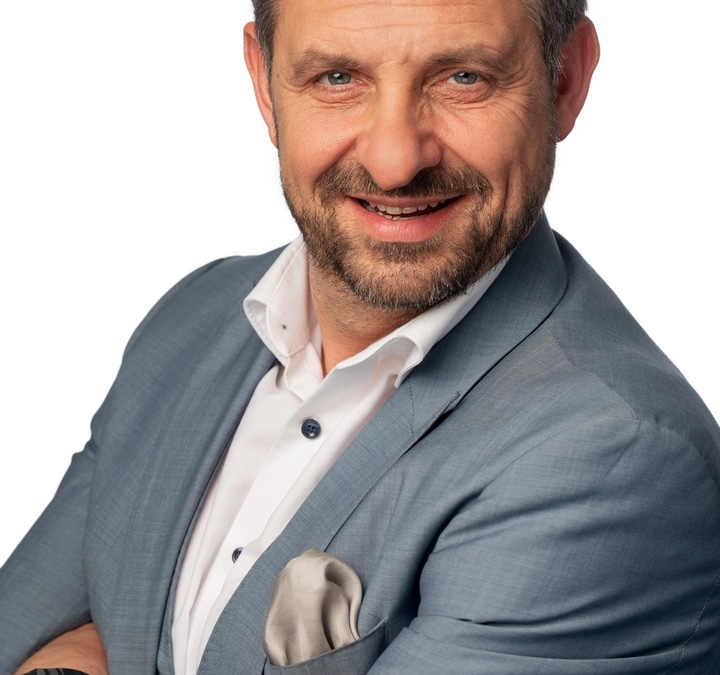
by Hydrogeit | Mar 7, 2024 | Europe, Germany, international, News, Policy
Interview with Jorgo Chatzimarkakis, CEO of Hydrogen Europe
There is a lot that needs sorting out at a political level: A large number of industry representatives are waiting for politicians in Brussels and Berlin to put regulatory safety nets in place so they can make appropriate decisions about their investments. H2-international asked Jorgo Chatzimarkakis, Europe’s “Mister Hydrogen” and CEO of Hydrogen Europe, about the European Union’s revised Renewable Energy Directive (RED III) and its Important Projects of Common European Interest (IPCEIs). The interview also touched on Germany’s 37th Ordinance on the Implementation of the Federal Immission Control Act (37th BImSchV) as well as the recently revealed problems with fuel cell buses and their refueling stations. His guest article about H2Global appears on page 48.
Advertisements

H2-international: Mr. Chatzimarkakis, fortunately the adoption of RED III didn’t take as long as RED II. What do you think of the outcome?
Chatzimarkakis: The adoption of RED III is a positive step for the hydrogen industry in Europe. It provides clarity and the basis for funding and developing hydrogen projects and applications. That said, it’s important that it’s swiftly implemented so that the sector has the necessary planning certainty to make investment decisions.
The extremely arduous procedure for IPCEI projects has been a massive headache for the H2 industry. Apparently there should now be some movement. Can you confirm that and shed some light on it?
Yes, the delays in IPCEI projects have troubled the industry, caused by bureaucracy at either a European or national level. The consequence has been that funding recipients have to wait too long and then they back out. That harbors the risk that projects could be carried out in the USA, for example. We can’t afford to lose any time as the creeping deindustrialization process is accelerated by such unnecessary delays. To counteract this, I was able to get things moving for one process or another. The IPCEI initiatives are crucial for the development of the hydrogen economy and the funding of innovation. It’s important that the bureaucratic hurdles are surmounted so these projects can move forward.
What feedback do you get from your members? Do they regret having applied in the first place?
Some of our members have expressed concerns about the long delays for IPCEI projects. They have invested considerable resources in the applications and are waiting for the green light in order to move their projects forward. It’s understandable that they are frustrated by the continuing uncertainties.
What’s your advice? To forgo funding and start something quickly themselves or to continue to wait?
The decision whether to forgo funding and start independently or to wait depends on each company’s individual circumstances. However, it’s important that funding is released as quickly as possible to support urgently needed hydrogen projects and accelerate rollout.
Sadly, the production of green hydrogen is still associated with high capital expenditure and financial risks. Despite funding, the long-term operation of a plant for producing green hydrogen on an industrial scale is often not viable. That’s why we still need alternative hydrogen production pathways which can produce more competitively.
Let’s turn our attention to Germany: Many have been waiting a number of years for the 37th BImSchV. To your knowledge, when will there be a new ordinance and what, to your knowledge, will it contain?
It’s regrettable that the revision of the 37th BImSchV is taking so long. Unfortunately, I don’t have any precise information on when a new ordinance is expected or what it will contain exactly. However, it’s essential that the ordinance takes into consideration the needs of the hydrogen industry and the requirements for reliable and efficient hydrogen production.
Allow me to ask two or three questions about the open letter that Hydrogen Europe recently received (H2-international has a copy). In it, various high-ranking industry representatives from the JIVE, JIVE 2 and MEHRLIN project consortium ask for an “improvement to the hydrogen refueling infrastructure for FC buses.” Did you receive this letter?
Yes, we received the open letter. We take the concerns of the industry representatives very seriously. Improving the hydrogen refueling infrastructure for fuel cell buses is of critical importance to support the spread of eco-friendly means of transportation. Waste-to-hydrogen, in particular, could be a piece in the puzzle. That’s because the costs of production, for example from biogas, are two to three euros per kilogram. Combined with the GHG quota, that quickly becomes viable.
The letter also says: “The members of the consortium are convinced that FC buses can be a practicable option for public transport throughout Europe. They have proven themselves to be reliable and have been well received by both passengers and bus drivers. However, the consortium is of the opinion that the technical readiness and the capabilities of hydrogen refueling stations (HRS) fall well below the requirements for the operation of an FC bus fleet. The consortium believes that this represents a huge obstacle and a limitation for the commercialization and proliferation of FC buses and could in fact represent a challenge for FC vehicles across Europe and perhaps, indeed, the world.” You are urged in this letter to recognize the significance of this problem and to conduct talks with industry about possible solutions as a matter of urgency. What’s your response to this?
The consortium’s concerns are justified. We’re supporting efforts to improve the hydrogen refueling infrastructure for fuel cell buses. For instance, we and our member companies are actively involved in standardization in this area – for example with ISO and UNECE. It’s important that industry and political decision-makers work together to find solutions to this challenge and to ensure that fuel cell buses are able to realize their full potential.
What’s more, AFIR [Alternative Fuel Infrastructure Regulation] is sure to have a very positive effect on the ramp-up in refueling. It obliges EU member states to build hydrogen refueling stations at central European intersections and in city hubs. We’ve calculated that up to 600 refueling stations in total will need to be built within the EU by 2030. That will give a considerable boost to users of fuel cell buses.
Does that mean you will address this problem – including in the interests of your association members?
Yes, Hydrogen Europe is actively addressing this issue and is advocating for the improvement of hydrogen refueling infrastructure. We are committed to representing the interests of our association members and driving forward the development of the entire hydrogen economy in Europe.
Interviewer: Sven Geitmann
Extracts from the open letter
“If there is something needed for the commercial operation of buses in public transport systems, then it is an HRS that is reliable and available for operation. This basic standard is frequently unmet at current refueling units. Almost all sites in the JIVE, JIVE 2 and MEHRLIN projects experienced considerable downtimes for the refueling unit, meaning that vehicles were not deployable.”
“It took many months to achieve a reliable and robust refueling process, and during that time numerous faults occurred in the course of the refueling process which took considerable time to be remedied by the supplier – and this despite the inherent redundancy of the station.”
“Consortium members report problems with a range of essential hydrogen dispensing equipment. These problems are surprising given the extensive experience of hydrogen handling in industry.”
“Furthermore, the problems and comments are similar to those reported in numerous projects in the early 2000s. It is remarkable and extremely disappointing that the performance of compressors for the refueling of FC buses has clearly not yet reached the level necessary for the operation of a commercial fleet.”
“The project sites have reported that data transmission is often interrupted which causes refueling to stop or leads to refueling taking longer than necessary. The sensor in the nozzle is not robust. If it fails, the entire fuel nozzle unit has to be replaced at a cost of EUR 10,000.”
“Significant problems occurred in buses when tanks were converted from Type 3 to Type 4. At least in some cases, this appears to be due to information from the bus manufacturers not being passed on to the HRS OEMs.”
“Indeed, the HRS availability targets of above 98 percent had already been met, e.g., by some sites in the CHIC project; yet this level of performance was only achieved with considerable deployment of staff and financial input, in other words with higher costs.”
“Commercial operators require their vehicles to be available whenever and wherever they are needed (and at reasonable operating costs). This is perhaps the most important variable considered by operators if they are contemplating investments in new or additional vehicles. If they cannot be certain that the vehicles can be refueled when needed, none of the plans for expanding the fleet of FC buses will go ahead.”
“It is our opinion that the continuing refueling problems must be resolved if the EUR 407 million that have been invested in FC buses over the past 20 years from EU public funds as well as funds from industry, bus operators, SMEs and research partners is to result in the long-term commercialization of the buses. We are convinced that they can be quickly resolved if they receive the necessary attention and the requisite resources.”
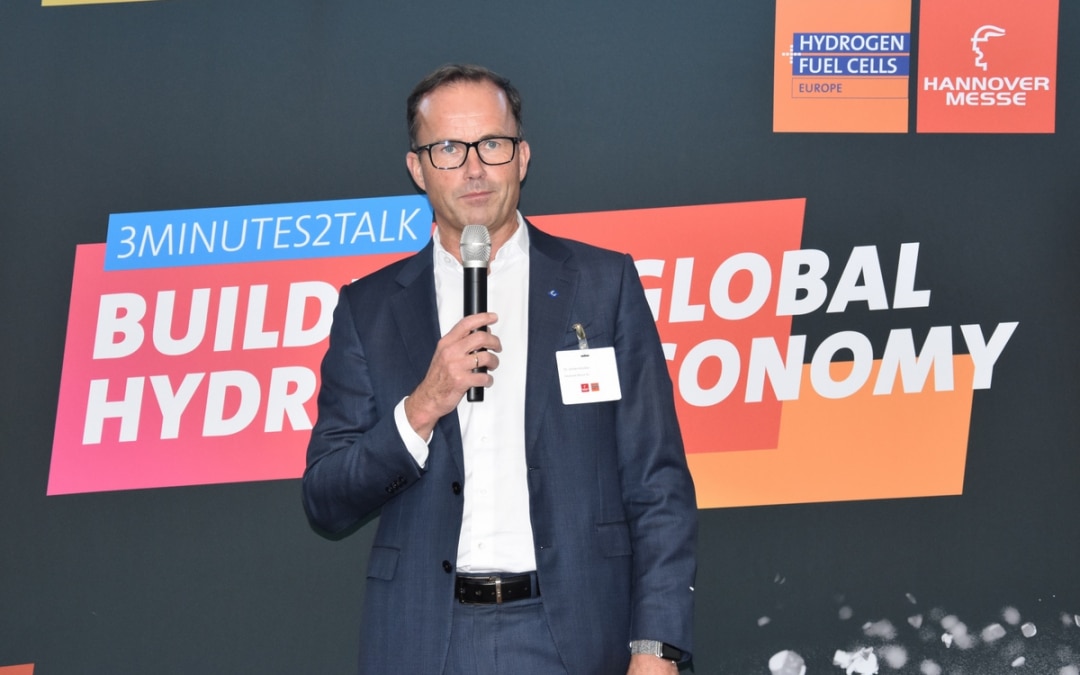
by Hydrogeit | Mar 5, 2024 | Europe, Fairs and conferences, Germany
Interview with Dr. Jochen Köckler, chairman of Deutsche Messe
“We’re bringing people together.” With these words Dr. Jochen Köckler, board chairman of Deutsche Messe, described Hannover Messe’s ambition to once again be the place to go in real life for exhibitors and visitors in the industrial sector in 2024. This year, the focus will be even more on hydrogen than in 2023. Köckler emphasized the need for more togetherness by saying that the establishment of an H2 economy will “only succeed if people from politics and commerce work together.”
Advertisements

H2-international: Dr. Köckler, in 2023, hydrogen was already one of the five core topics you showcased during Hannover Messe. Will the presence of H2 technology increase again in 2024?
Köckler: We assume that we will experience a significant increase in the area of hydrogen. At Hydrogen + Fuel Cells Europe as well as in the other exhibition areas of Hannover Messe, the signs are pointing to growth.
H2-international: What will you, on the part of Deutsche Messe, do in order to underline the major importance of the topic hydrogen?
Köckler: With Norway as this year’s partner country, we are focusing on the topic of energy, and with that especially the topic of hydrogen. Germany and Norway agreed on an energy cooperation back in January 2023. In the joint declaration on hydrogen, the two countries reaffirmed their intention to establish a large-scale supply of hydrogen, including the necessary infrastructure, by 2030. Norway will therefore position itself with its joint stand in the energy section of the Hannover Messe.
H2-international: With Hydrogen + Fuel Cells Europe, one of the most important H2 trade fairs in Europe is part of your industry show. What can visitors expect there?
Köckler: Hydrogen + Fuel Cells Europe has been the meeting place for the international community for around 30 years. They meet there, they discuss all critical topics in two forums there. The Public Forum deals with current topics such as the question of what contribution hydrogen can make to reducing CO2. In the Technical Forum, new products and solutions are presented. Visitors who are interested in the topic of hydrogen will be given a comprehensive overview of technical innovations there but also of different fields of application.
But H2 solutions will be shown not only at the Hydrogen + Fuel Cells Europe in hall 13, but also in other areas of the Hannover Messe. We are pleased that increasingly more exhibitors with hydrogen-related and fuel cell-related products are represented. In total, we expect more than 500 companies in Hannover. This will give the hydrogen economy a real boost. Salzgitter AG, for example, is informing on climate-neutral production of green steel from green hydrogen in hall 13.
H2-international: Were you at the Hydrogen Technology Expo in Bremen? Are you impressed by how quickly this trade fair has grown and how professionally it has matured?
Köckler: When a topic gains in importance, new opportunities for trade fairs naturally arise. That is normal. Our advantage is that we have been working in the field of hydrogen and fuel cells for decades and, in all this time, have established a unique community. This appreciates the integration of Hydrogen + Fuel Cells Europe in Hannover Messe, as it has direct access to industry, the energy sector and politics here. No other trade fair in the world has this.
H2-international: What is your view of the German events sector? What are the advantages of Hannover Messe compared to now large European H2 trade fairs such as those in Rotterdam or Paris?
Köckler: Hannover Messe is a horizontal trade fair at which representatives from politics, commerce and academia exchange ideas every year. They cross-fertilize each other and work together to drive developments forward. In hall 2, for example, scientists from leading research institutes will be showing what products and solutions are being researched. In the other halls of the Hannover Messe, the focus is on specific applications. Politics will be even more strongly represented this year than in previous years, as in addition to the German chancellor Olaf Scholz, German economy minister Robert Habeck and Ursula von der Leyen, the president of the European Commission, are expected
The EU will be strongly represented overall. On the first day of the fair, the EU conference “EU as Home of the Decarbonised Industry” is taking place in the Convention Center on the fairgrounds in Hannover. At the event, industry representatives can exchange ideas with high-ranking EU politicians to discuss relevant topics such as the Green Deal. This possibility only Hannover Messe offers. Particularly in the energy sector is contact with politicians important, as all political decisions in this area have an impact on businesses.
Interviewer: Sven Geitmann
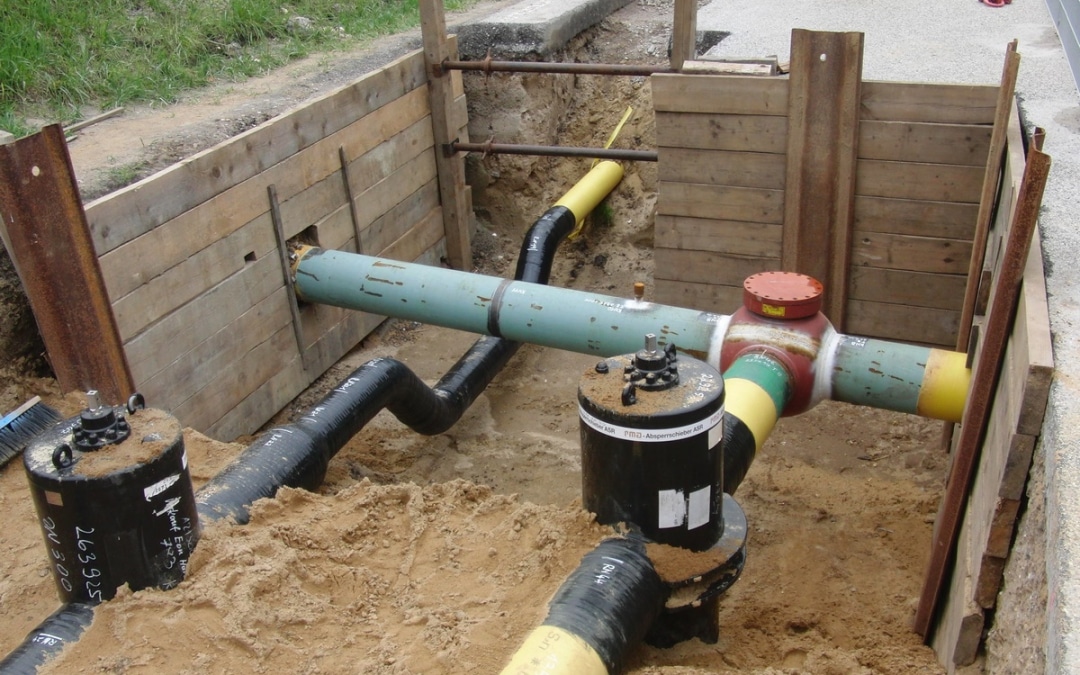
by eaugsten | Feb 26, 2024 | Europe, Germany, News
Hydrogen in the existing natural gas network
Whether hydrogen contributes to the clean heating transition will also depend on how easily existing natural gas networks can be converted. This is what Gasnetz Hamburg wants to find out in the project H2Switch100. For this, the company is looking at a very ordinary section of its existing network.
Advertisements

There’s nothing special about the small grid section in the southern district of Hamburg – exactly why the grid operator Gasnetz Hamburg chose it. In total 16 connections, including 14 normal households, a business park and a sports club. In the residential buildings, natural gas heating systems are installed. The business park and sports club operate a combined heat and power plant with natural gas. There are in the partial network new PE (polyethylene) pipes as well as old steel pipes and house connections from various decades. “The network section is representative for Hamburg’s gas grid,” said Sebastian Esser, project leader at Gasnetz Hamburg.
The aim is to find out whether other ordinary network sections could also be converted to hydrogen. The mix of materials and designs distinguishes H₂-SWITCH100 from the longer-running project H2Direkt of the company Thüga in Hohenwart. There, already in winter 2023/24, ten households and one commercial customer are to be supplied with pure hydrogen. However, only PE pipes, known to be suitable for hydrogen, are installed there (see p. 30).
Feasibility study with laboratory trials
In Hamburg, meanwhile, preliminary investigations are still pending. Together with the partners TÜV Süd and DBI Gas- und Umwelttechnik, Gasnetz Hamburg wants to demonstrate in a feasibility study within twelve months the integrity of the network for hydrogen. In the first step, samples from the original network will be sent to the lab. “For each component type that occurs in the network, we will examine at least one specimen,” said Esser.
In particular, these are individual gate valves and ball valves, but also entire service laterals and pieces of piping. In the laboratories of partner organizations, the components should then demonstrate that they are suitable for employment in a hydrogen network. Is there any embrittlement of the steel parts? Do the pressure regulators work? Are the shut-off devices tight? Answers to these questions are to be provided in the feasibility study running until August and funded by the investment bank IFB Hamburg (Hamburgische Investitions- und Förderbank).
“We’re very confident about the old components and the pipes themselves, as gas with about 50 percent hydrogen content was flowing through the pipes until the 1980s. Some components, however, were added later,” said Esser. The cost for this first project phase, according to Gasnetz Hamburg, lies “in the low six-figure range.”
Replace meter and burner
If the laboratory tests turn out positive, step 2 will follow: the actual conversion of the network. At issue will not be merely feasibility but also costs. Because even if the network is suitable for hydrogen, at the least the burner nozzles and the meters will probably have to be replaced. Lastly, the standard volume of gas must increase by a factor of three to compensate for the lower calorific value of hydrogen compared to natural gas.
“In the pipes themselves, this is no problem. Firstly, the hydrogen has a lower viscosity and therefore flows faster; secondly, we can slightly increase the pressure if necessary; and thirdly, the pipe diameters in the Hamburg gas grid are sufficiently dimensioned to accommodate the higher throughput,” erklärt Esser.
Many manufacturers already have up their sleeves heaters that can be operated with pure hydrogen, for the coming years. “As far as the combined heat and power plants are concerned, manufacturers have already announced their intention to make devices available for testing,” according to Esser. The additional costs incurred as a result of the pilot test will be borne by Gasnetz Hamburg. Thanks to this pledge, the supplier is being met with wide-open customer doors. “Even some neighbors who do not yet have a natural gas connection have now expressed an interest in hydrogen,” Esser recounted.
Hydrogen from planned industrial network
While the pipes and other components are very normal, the location of the network section is very special. It lies almost directly along the route for the already planned hydrogen network for the Hamburg industry with project name HH-WIN. Already in 2024, Gasnetz Hamburg wants to have built large parts of HH-WIN. In year 2027, the company intends to be able to supply the first hydrogen volumes. The confirmation that this will be an IPCEI (Important Project of Common European Interest), which is eligible for a particularly high level of funding, was still pending at the time of going to press.
“Compared to the needs of industry, the hydrogen requirement for the pilot project is minimal,” said Esser. The hydrogen for the industrial network is to come from three sources, which according to current announcements should all stand ready to be put into operation. On the one hand, there is the 100-megawatt electrolyzer that should appear directly in the industrial area at the site of the former coal-fired plant Kohlekraftwerk Moorburg. After some unrest within the project consortium, Hamburger Energiewerke wants to implement the project now together with asset manager Luxcara as majority shareholder. Commissioning is still targeted for 2026.
Secondly, hydrogen is to come to Hamburg via an ammonia terminal that Mabanft and Air Products announced at the start of 2022. By now, the project has undergone a nautical risk analysis, and the companies are in the process of compiling the documents for the approval procedure. As target year for commissioning Mabanaft still named 2026.
And thirdly, there is the European hydrogen core network of the grid operators. Both with the Netherlands and with Wilhelmshaven, Hamburg is connected by existing long-distance lines that are to be converted to hydrogen in the first project phase (see p. 30).
How low-CO2 the production of hydrogen will be in each case is difficult to say, as the regulations as well as the energy production and conversion are massively in motion.
Role of hydrogen in the heating transition unclear
If it turns out that the pipeline network could be easily repurposed, this does not make hydrogen the first choice for Hamburg’s heating transition. After all, in contrast to industry, there are many other options for heating buildings with significantly lower conversion losses. This consideration was once also the basis of the Wasserstoff-Roadmap (hydrogen roadmap), which prioritized – initially still scarce – green hydrogen for sectors that are difficult to decarbonize, including first and foremost industry. The environmental and energy office of Hamburg (BUKEA) also is following this strategy.
The Hanseatic city started collecting data for a heating register much earlier than most other large cities, and intends to present a complete heating plan already by 2024. In the city center, this will probably mainly be district heating, while heat pumps are popular in the peripheral areas.
“Certainly, converting the natural gas pipelines to pure hydrogen operation is not a solution for the whole of Hamburg,” acknowledged Michael Dammann, the technical managing director of Gasnetz Hamburg. “However, the further use of an already existing infrastructure with the green gas can be a sensible supplement to options like expansion of district heating and heat pumps in certain building structures and locations. With H₂-SWITCH100, we want to find out specifically what effort and costs are associated with such a changeover and whether there are technical hurdles.”
Author: Eva Augsten










